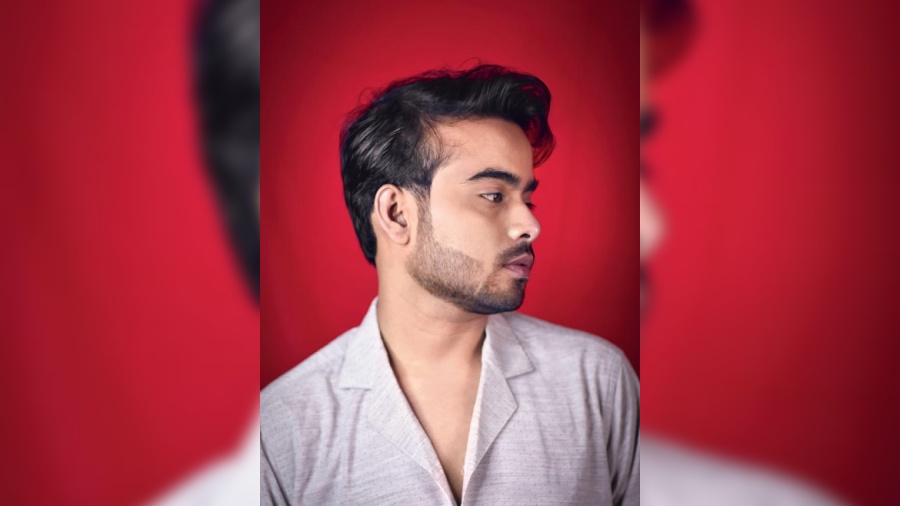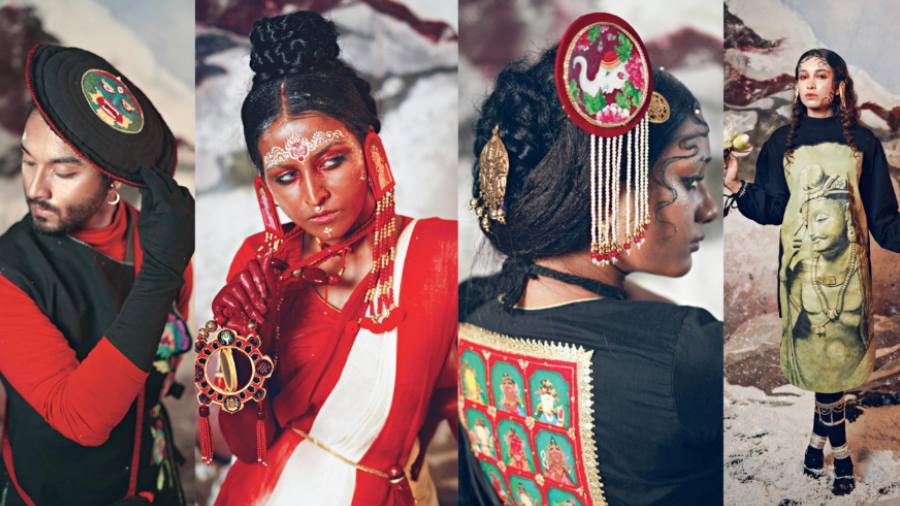Agnik Kolkata’s spring-summer 2022 collection Yatra is a visually engaging journey of colours, patterns, artistry and vivid imagination. We chatted with designer Agnik Ghosh to know about the inspirations and his mood board.
The collection has all your signatures. It’s highly artistic, experimental and statement. Can you tell our readers about the theme?
The great fabled monk of the 11th century, Atish Dipankara Srijjana travelled to Tibet through the ice-capped paths of Silk Route to spread the words of Lord Buddha. And, along with him he had carried ‘The seven mystic offerings of profound enlightenment’ or ‘The Saptagunas’. Inspired by this fable of wonder wrapped in history and spirituality, we have created our first artisanal collection named Yatra, a journey towards consciousness.
How much do you study to dig out these stories?
Well, this work is a result of almost two years of research work. The idea was to create a storyline which is probably unknown or lesser known to the mass. So I had inculcated a habit of studying old art forms, history, notes about Buddhist philosophy and literature quite diligently.
You say you are a history buff. Once you have read a story, how do you go about interpreting it?
It is an interesting but really long procedure. First we formulate a fictional storyline inspired by some historical incident. After which we have to study the timeline, the art forms, the political structure, and the costumes. Then comes colour study and forming a mood board and then finally creating each look.
Tell us how you shot this.
Well it was a mammoth task. My art director Anirban Mondal and cinematographer Anjanava Mitra together created this huge Diorama set mimicking the Himalayas! Along with this we created continuous snowfall out of plexi-glass to represent as if all the characters are travelling through ice. Lighting also plays a major role here since the entire ambience is set in a cool tone.
Can you decode the various elements of the collection?
It is a collection comprising a myriad range of clothing in myriad hues.... I took my own artistic liberty in creating clothes inspired by various cultural time frames. We have ensembles inspired by the Chinese qipao and ’20s cocoon coat to Roman toga-like dresses and hand-dyed Nauvari saris. We have used various surface embellishment techniques ranging from silk embroidery, kantha, aari, zardozi, applique and hand-painting. Use of rich silks to handwoven cottons was another characteristic. And for the first time we used 3D technique, wherein meticulously hand-tinted flowers and butterflies ornated the surfaces of our signature looks.
Who are the various characters?
Collectively called the Saptagunas, which means the seven divine qualities, the characters are mainly Nilotpala (immortality), Gaureshwari (valour), Samriddhasundari (prosperity), Komal-Gandhar (wisdom), Vikrama (fearlessness), Vriddhi (fortune) and Parivrajika (beauty). The interesting part is that each of the characters come from a specific region connected with the famous fabled network of Silk Route.
Can you tell us about the hair and make-up?
Making each look distinctive was quite a laborious task and Sukalpita and Sandipta, our make-up artist and hairstylist, made it possible. Each look was meticulously created keeping in mind what character they represent. Mostly, we went for a pale look with less contour, rosy cheeks and frosty lips. Use of iridescent snowflakes to represent as if they are out of a hailstorm was an interesting feature. As for the hairstyles, we referred to mainly Tibetan, Pala and Gandhara art and created huge bouffants and dainty ringlets to give each character a sculpturesque look.
Tell us a bit about the accessories...
The main accessories that we created to complete the collections were headdresses and jewellery. The headgears ranged from painted ‘Pala planks’ and quilted hats to bejewelled Tibetan crowns. For the jewellery our designer Kaushik created these three-dimensional kinetic jewellery out of wood which moved and rotated around various axes, hence giving the wearer a different look from multiple angles.
How do you style your collections?
Styling is something which I believe is carried out in correspondence to the major outfit. Each look has a separate styling process as each has a separate mood.
Who is your fave character from history?
Well there are innumerable and it’s really hard to pick one because a lot of time they are anonymous like the Shalabhanjika from Sanchi or the Alas Kanyas of Khajuraho. From Mughal miniatures of Nur Jahan to ‘Bodhisattavas’ of Ajanta, the list is endless.













